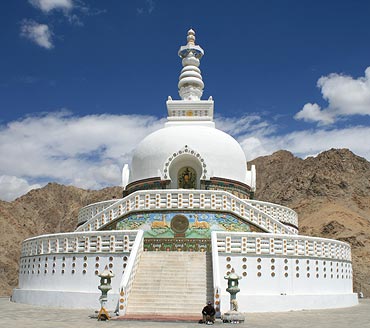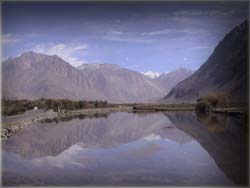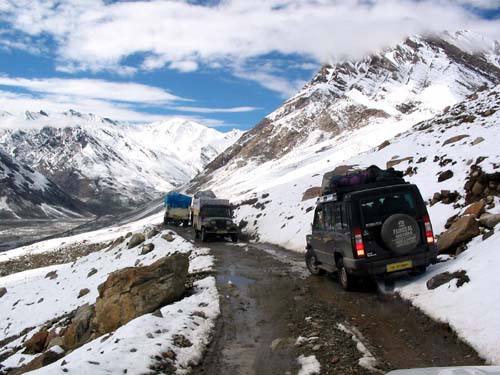Places to visit in Leh Ladhak
Leh Palace: The former Palace of the King of Ladakh (admission 100rps). The most noticeable building in Leh, the palace was built in the 17th century, and now undergoing restoration.
 leh Palace
leh Palace
Buddhist temples:
.Namgyal Tsemo Gompa temple:

Namgyal Tsemo Gompa - above the Palace, built 1430, is only open from 7AM-9AM during the morning puja
Soma Gompa temple :

Soma Gompa - just around the corner from Main Bazar, it's a large modern gompa. It's also the location of the Ladakhi Buddhist Association, a conservitive political orginisation, with ties to Hindutva groups.
Karma Dupgyud Choeling temple:

Karma Dupgyud Choeling - monastery in the Karma Kagyu tradition
Shanti Stupa:

Shanti Stupa : built by a Japanese Buddhist group. This modern stupa is somewhat kitschy, but still worth a visit.
Pangong Tso Lake:

Pangong Tso, A beautiful high altitude lake at 4350 meters with deep blue waters, surrounded by tall mountain peaks. This lake lies on the Indo - China boundary, with only one fourth of the lake being in India. The road to this lake passes through Chang-la pass , claimed to be at 5425 meters. It's a five hour drive (149 Kms) from Leh to this place. There is also a small camp on the way where a Yak Safari can be done. The passage is also very tough to cross by car. So a four-wheel drive car is recommended. Experienced bikers should not have any problem. Day return trips from Leh avoid the AMS issue , but you won't be able to see much during the your 60 minutes stay there .Overnight trips directly from Leh is outside safety guidelines . The safe and comfortable option is to plan this trip at the end of your stay in Leh , and with a overnight stop at Tangtse (altitude 3950) .
Places to see around Leh:
Hemis Gonpa:
Hemis is a town in India 40 km southeast of Leh in Ladakh, well known for the Hemis monastery that was established in 1672 AD by king Senge Nampar Gyalva. Hemis is best known to tourists for the colorful festival held in July. Hemis also could be associated with the Hemis National Park, an area that is home to the endangered snow leopard. The national park was created in 1981.

Shey Palace:
The Shey Monastery or Gompa and the Shey Palace complex are structures located on a hillock in Shey,15 kilometres (9.3 mi) to the south of Leh in Ladakh, northern India on the Leh-Manali road. Shey was the summer capital of Ladakh in the past.
 The palace, mostly in ruins now, was built first in 1655, near Shey village, by the king of Ladakh, Deldan Namgyal, also known as Lhachen Palgyigon. It was used as a summer retreat by the kings of Ladakh.
The palace, mostly in ruins now, was built first in 1655, near Shey village, by the king of Ladakh, Deldan Namgyal, also known as Lhachen Palgyigon. It was used as a summer retreat by the kings of Ladakh.
Stok Palace and Museum:
Stock Palace Museum is 10 km south of Leh. It is the palace museum where the royal family resides and on display are the royal paraphernalia including some precious stones, many 400 year old tangkhas, coins, royal crowns, dresses and prayer instruments.

Thiksey Gonpa:
Thikse Gompa or Thikse Monastery is a Tibetan Buddhist monastery of the Yellow Hat (Gelugpa) sect, located on top of a hill, approximately 19 kilometres east of Leh in Ladakh, India. It is noted for its resemblance to the Potala Palace in Lhasa, Tibet and is the largest gompa in central Ladakh.

The monastery is located at an altitude of 3,600 metres (11,800 ft) in the Indus valley. It is a 12-storey complex and houses many items of Buddhist art such as stupas, statues, thangkas, wall paintings and swords. One of the main points of interest is the Maitreya (future Buddha) Temple which is installed to commemorate the visit of the 14th Dalai Lama to this monastery in 1970. A 15 metres (49 ft) high statue of Maitreya, the largest such statue in Ladakh, covering two storeys of the building is defied in the monastery. A nunnery is also part of the complex
Alchi Choskor:
Alchi monastery was founded by the great translator Lotsava Rinchen Zangpo in 11th century AD.
The exquisite murals of Alchi Choskor are world famous and it is said that the artists were specially brought from Kashmir

Lamayuru Gonpa:
Lamayuru or Yuru Gompa is a Tibetan Buddhist Gompa (monastery) in Kargil District, Western Ladakh, situated on the Srinagar - Kargil - Leh road 15 km east of the Fotu La, at a height of 3,510 m.

Around Nubra Valley
Nubra Valley is about 150 km north of Leh, the capital town of Ladakh, India. Local scholars say that its original name was Ldumra (the valley of flowers). The Shyok River meets the Nubra or Siachan River to form a large valley that separates the Ladakh and the Karakoram Ranges. The average altitude of the valley is about 10,000 ft. above the sea level. The common way to access this valley is to travel over the Khardung La from Leh. Non-locals require an Inner Line Permit(obtainable in Leh town) to enter Nubra.
Deskit:
It has a monastery atop a hillock from where you can also enjoy panoramic view of the valley. Deskit sand dunes and double-humped camel ride reminds of silk route tradition.

Sumur:




Tsokar:
A twin lake Tsokar and Tarsaphuk tso form the part of a wide picturesque valley with many wildlife including migratory birds, wild asses (Kyangs) and Changpa nomads with thousands of livestock including sheep, goats and yaks live in their tents around the lakes in the vast expanse of pasture.

Pangong:
Pangong Tso (or Banggong Co Lake) is an endorheic lake in the Himalayas situated at a height of about 4,350 m (14,270 ft). It is 134 km (83 mi) long and extends from India to Tibet. 60% of the length of the lake lies in China. The lake is 5 km (3.1 mi) wide at its broadest point. During winter the lake freezes completely, despite being saline water.

Pangong Tso lake
Kargil:
Kargil is a town, which serves as the headquarters of Kargil District of Ladakh in the state of Jammu and Kashmir in India. It is the second largest town in Ladakh after Leh. It is located 60 km and 204 km from Drass and Srinagar to the west respectively, 234 km from Leh to the east, 240 km from Padum to the southeast and 1,047 km to Delhi in the south.

Drass:
Dras is a town in the Kargil District of Jammu and Kashmir, India. It is often called 'The Gateway to Ladakh'The town shot into prominence in the summer of 1999 following Pakistani-backed incursions into Jammu and Kashmir. TheKargil War saw the town being shelled by infiltrators and the war ended with the Indian Army recapturing the areas surrounding the town and the Kargil district.

Suru Valley:
The Suru valley is a valley in the Ladakh region of Jammu and Kashmir, which is drained by the Suru River (Indus), a powerful tributary of the Indus river. The valley's most significant town is Kargil.

Zanskar:
Zanskar is a subdistrict or tehsil of the Kargil district, which lies in the eastern half of the Indian state of Jammu and Kashmir. The administrative centre is Padum. Zanskar, together with the neighbouring region of Ladakh, was briefly a part of the kingdom of Guge in Western Tibet.

Leh Palace: The former Palace of the King of Ladakh (admission 100rps). The most noticeable building in Leh, the palace was built in the 17th century, and now undergoing restoration.

Buddhist temples:
.Namgyal Tsemo Gompa temple:

Namgyal Tsemo Gompa - above the Palace, built 1430, is only open from 7AM-9AM during the morning puja
Soma Gompa temple :

Soma Gompa - just around the corner from Main Bazar, it's a large modern gompa. It's also the location of the Ladakhi Buddhist Association, a conservitive political orginisation, with ties to Hindutva groups.
Karma Dupgyud Choeling temple:

Karma Dupgyud Choeling - monastery in the Karma Kagyu tradition
Shanti Stupa:

Shanti Stupa : built by a Japanese Buddhist group. This modern stupa is somewhat kitschy, but still worth a visit.
Pangong Tso Lake:

Pangong Tso, A beautiful high altitude lake at 4350 meters with deep blue waters, surrounded by tall mountain peaks. This lake lies on the Indo - China boundary, with only one fourth of the lake being in India. The road to this lake passes through Chang-la pass , claimed to be at 5425 meters. It's a five hour drive (149 Kms) from Leh to this place. There is also a small camp on the way where a Yak Safari can be done. The passage is also very tough to cross by car. So a four-wheel drive car is recommended. Experienced bikers should not have any problem. Day return trips from Leh avoid the AMS issue , but you won't be able to see much during the your 60 minutes stay there .Overnight trips directly from Leh is outside safety guidelines . The safe and comfortable option is to plan this trip at the end of your stay in Leh , and with a overnight stop at Tangtse (altitude 3950) .
Places to see around Leh:
Hemis Gonpa:
Hemis is a town in India 40 km southeast of Leh in Ladakh, well known for the Hemis monastery that was established in 1672 AD by king Senge Nampar Gyalva. Hemis is best known to tourists for the colorful festival held in July. Hemis also could be associated with the Hemis National Park, an area that is home to the endangered snow leopard. The national park was created in 1981.

Shey Palace:
The Shey Monastery or Gompa and the Shey Palace complex are structures located on a hillock in Shey,15 kilometres (9.3 mi) to the south of Leh in Ladakh, northern India on the Leh-Manali road. Shey was the summer capital of Ladakh in the past.

Stok Palace and Museum:
Stock Palace Museum is 10 km south of Leh. It is the palace museum where the royal family resides and on display are the royal paraphernalia including some precious stones, many 400 year old tangkhas, coins, royal crowns, dresses and prayer instruments.

Thiksey Gonpa:
Thikse Gompa or Thikse Monastery is a Tibetan Buddhist monastery of the Yellow Hat (Gelugpa) sect, located on top of a hill, approximately 19 kilometres east of Leh in Ladakh, India. It is noted for its resemblance to the Potala Palace in Lhasa, Tibet and is the largest gompa in central Ladakh.

The monastery is located at an altitude of 3,600 metres (11,800 ft) in the Indus valley. It is a 12-storey complex and houses many items of Buddhist art such as stupas, statues, thangkas, wall paintings and swords. One of the main points of interest is the Maitreya (future Buddha) Temple which is installed to commemorate the visit of the 14th Dalai Lama to this monastery in 1970. A 15 metres (49 ft) high statue of Maitreya, the largest such statue in Ladakh, covering two storeys of the building is defied in the monastery. A nunnery is also part of the complex
Alchi Choskor:
Alchi monastery was founded by the great translator Lotsava Rinchen Zangpo in 11th century AD.
The exquisite murals of Alchi Choskor are world famous and it is said that the artists were specially brought from Kashmir

Lamayuru Gonpa:
Lamayuru or Yuru Gompa is a Tibetan Buddhist Gompa (monastery) in Kargil District, Western Ladakh, situated on the Srinagar - Kargil - Leh road 15 km east of the Fotu La, at a height of 3,510 m.

Around Nubra Valley
Nubra Valley is about 150 km north of Leh, the capital town of Ladakh, India. Local scholars say that its original name was Ldumra (the valley of flowers). The Shyok River meets the Nubra or Siachan River to form a large valley that separates the Ladakh and the Karakoram Ranges. The average altitude of the valley is about 10,000 ft. above the sea level. The common way to access this valley is to travel over the Khardung La from Leh. Non-locals require an Inner Line Permit(obtainable in Leh town) to enter Nubra.
Deskit:
It has a monastery atop a hillock from where you can also enjoy panoramic view of the valley. Deskit sand dunes and double-humped camel ride reminds of silk route tradition.

Sumur:
Sumur Village has a good collection of tangkhas, Buddha idols and frescoes. The village of Panamik is famous for its hot water sulphur springs. Close to the village of Sumur, lies a beautiful camp site by the river. Camping is suggested for a day or two.


Panamik:
Panamik is approximately 150 kms away from Leh. It is quite a scenic village. Road to Panamik is well laid. People are friendly and helpful. The color of the trees during the months of Sep and Oct turns to yellowish red and is a treat to watch. The gentle Nubra enhance the charm. The mountains just rise from the valley as some child has made them of mud. Snow can be seen on the peaks.

Changthang:
Tsomoriri Lake is located in Changthang approx. 240 Kms. from Leh. The Lake is around 28 Kms. long and around 8 Kms wide at an altitude of 14,000 ft, above the sea level. It harbors many species of migratory birds including Brahmini Duck, Rudy Shelduck etc. The Korzok village settlement with a monastery close to the lake has its own appeal.

Tsokar:
A twin lake Tsokar and Tarsaphuk tso form the part of a wide picturesque valley with many wildlife including migratory birds, wild asses (Kyangs) and Changpa nomads with thousands of livestock including sheep, goats and yaks live in their tents around the lakes in the vast expanse of pasture.

Pangong:
Pangong Tso (or Banggong Co Lake) is an endorheic lake in the Himalayas situated at a height of about 4,350 m (14,270 ft). It is 134 km (83 mi) long and extends from India to Tibet. 60% of the length of the lake lies in China. The lake is 5 km (3.1 mi) wide at its broadest point. During winter the lake freezes completely, despite being saline water.

Pangong Tso lake
Kargil:
Kargil is a town, which serves as the headquarters of Kargil District of Ladakh in the state of Jammu and Kashmir in India. It is the second largest town in Ladakh after Leh. It is located 60 km and 204 km from Drass and Srinagar to the west respectively, 234 km from Leh to the east, 240 km from Padum to the southeast and 1,047 km to Delhi in the south.

Drass:
Dras is a town in the Kargil District of Jammu and Kashmir, India. It is often called 'The Gateway to Ladakh'The town shot into prominence in the summer of 1999 following Pakistani-backed incursions into Jammu and Kashmir. TheKargil War saw the town being shelled by infiltrators and the war ended with the Indian Army recapturing the areas surrounding the town and the Kargil district.

Suru Valley:
The Suru valley is a valley in the Ladakh region of Jammu and Kashmir, which is drained by the Suru River (Indus), a powerful tributary of the Indus river. The valley's most significant town is Kargil.

Zanskar:
Zanskar is a subdistrict or tehsil of the Kargil district, which lies in the eastern half of the Indian state of Jammu and Kashmir. The administrative centre is Padum. Zanskar, together with the neighbouring region of Ladakh, was briefly a part of the kingdom of Guge in Western Tibet.




1 comments:
You have given a very good information on Ladakh and places to visit in Ladakh. Your blog provides a good information on Ladakh places and this information will be valuable to other tourists.
http://www.tourismladakh.com
Post a Comment